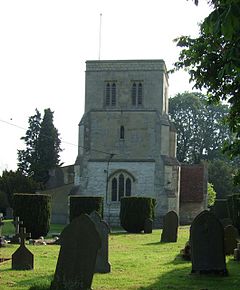Cheddington
| Cheddington | |
|---|---|
 St. Giles' parish church tower |
|
| Cheddington shown within Buckinghamshire | |
| Population | 1,754 (2011 Census) |
| OS grid reference | SP9217 |
| Civil parish |
|
| District | |
| Shire county | |
| Region | |
| Country | England |
| Sovereign state | United Kingdom |
| Post town | Leighton Buzzard |
| Postcode district | LU7 |
| Dialling code | 01296 |
| Police | Thames Valley |
| Fire | Buckinghamshire |
| Ambulance | South Central |
| EU Parliament | South East England |
| UK Parliament | |
| Website | Welcome to Cheddington |
Cheddington is a village and civil parish in the Aylesbury Vale district of Buckinghamshire. The parish has an area of 1,429 acres (578 ha). The village is about 6 miles north-east of Aylesbury and three miles north of Tring in Hertfordshire. The hamlet of Cooks Wharf has grown up where the main road into the village from Pitstone crosses the Grand Union Canal.
At Southend Hill near the village are the remains of an Iron Age hill fort which has been largely obliterated through arable cultivation.
The earliest known record of the village is in the Domesday Book in which it is called Cetendone, which is Old English for "Cetta's Hill". The Church of England parish church of Saint Giles was originally Norman. There is also a Methodist church with a large congregation.
Cheddington manor house is a much gabled and half timbered red brick building under a tiled roof, dating from the 16th century.
In 1963 Cheddington featured in the national press as it was near the location of the "Great Train Robbery" of 1963 at Bridego Railway Bridge in the hamlet of Ledburn.
In 1984, again Cheddington achieved national notoriety as the location of the first assault by Malcolm Fairley, a violent armed rapist, nicknamed "The Fox" because of his cunning nocturnal attacks.
...
Wikipedia

